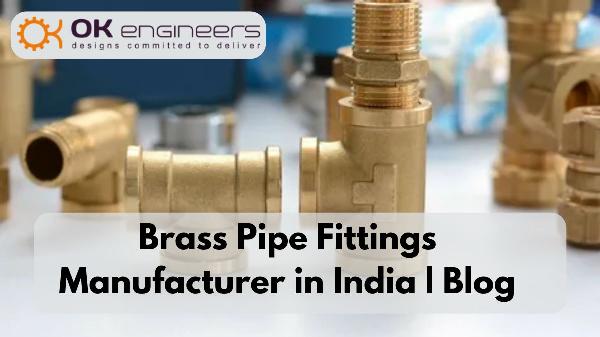All About The Limited Steel Components | OK Engineers

Strong 8k brings an ultra-HD IPTV experience to your living room and your pocket.
Iron and carbon make up the majority of steel, an alloy that is essential to modern industry and engineering. Steel is a vital material in many applications due to its strength and adaptability. Steel components are used in many different sectors for everything from simple tools to intricate machinery pieces. One of the leading names in the field, OK Engineers, is crucial in providing premium Steel Components to satisfy a range of requirements.
Carbon Steel Components
Carbon Steel Components are widely used in industries due to their excellent balance of strength and ductility. The carbon content in steel significantly influences its properties, making it suitable for different applications:
Low Carbon Steel: Also known as mild steel, this type has a carbon content of up to 0.3%. It is highly ductile and malleable, making it ideal for manufacturing components such as pipes, wire, and sheets. Low carbon steel is also used in structural applications like beams and panels due to its ease of fabrication and welding.
Medium Carbon Steel: With a carbon content between 0.3% and 0.6%, medium carbon steel offers higher strength and hardness compared to low carbon steel. It is commonly used in the production of automotive parts, machinery components, and forging. This type of steel is suitable for applications requiring a balance between strength and toughness.
High Carbon Steel: Containing carbon content between 0.6% and 1.0%, high carbon steel is extremely strong and hard. It is used in the manufacturing of cutting tools, blades, and springs. Despite its brittleness, high carbon steel is preferred for applications requiring wear resistance and the ability to hold a sharp edge.
Components of Stainless Steel Alloy
Components of Stainless Steel Alloy are renowned for their exceptional corrosion resistance and strength. Stainless steel alloys are composed of iron, carbon, and a minimum of 10.5% chromium, which forms a passive layer of chromium oxide on the surface, preventing rust and corrosion:
Austenitic Stainless Steel: This type is the most widely used and contains high levels of chromium and nickel. It is non-magnetic and exhibits excellent corrosion resistance. Components made from austenitic stainless steel are used in kitchenware, chemical processing equipment, and medical instruments.
Ferritic Stainless Steel: With moderate chromium content and little or no nickel, ferritic stainless steel is magnetic and has good corrosion resistance. It is often used in automotive applications, industrial machinery, and structural components.
Martensitic Stainless Steel: This type has higher carbon content and is known for its hardness and strength. It is magnetic and less corrosion-resistant compared to austenitic and ferritic stainless steel. Martensitic stainless steel components are used in cutlery, surgical instruments, and turbine blades.
Duplex Stainless Steel: Combining the properties of austenitic and ferritic stainless steel, duplex stainless steel offers high strength and excellent corrosion resistance. It is used in applications such as chemical processing, oil and gas industries, and marine environments.
Steel Structure Components
Steel Structure Components form the backbone of modern infrastructure. Steel's versatility and strength make it ideal for constructing buildings, bridges, and other structures:
Beams and Columns: Steel beams and columns are essential in the construction of buildings and bridges. They provide the necessary support and load-bearing capacity to ensure structural stability. Different types of beams, such as I-beams and H-beams, are used depending on the specific requirements of the structure.
Trusses and Frames: Steel trusses and frames are used to create frameworks for roofs, bridges, and towers. They are designed to distribute loads efficiently and provide stability. The use of steel allows for the construction of lightweight yet robust structures.
Reinforcement Bars (Rebars): Rebars are used to reinforce concrete structures, providing additional tensile strength. They are essential in the construction of foundations, walls, and slabs. The combination of steel and concrete results in a composite material that can withstand various stresses and loads.
Steel Plates and Sheets: Steel plates and sheets are used in the construction of ship hulls, storage tanks, and pressure vessels. Their high strength and durability make them suitable for applications requiring resistance to harsh environments and high pressures.
Stainless Steel Components Manufacturers India
India is home to numerous manufacturers of Stainless Steel Components, catering to both domestic and international markets. These manufacturers produce a wide range of components for various industries, ensuring high quality and precision. OK Engineers is a notable name among them, recognized for its commitment to excellence and innovation.
Automotive Industry: Stainless steel components are crucial in the automotive industry, where durability and resistance to corrosion are essential. Manufacturers produce exhaust systems, fuel tanks, and structural components that meet stringent quality standards.
Construction Industry: In construction, stainless steel components are used for architectural features, cladding, and structural elements. Manufacturers ensure that these components are aesthetically pleasing and structurally sound.
Medical and Pharmaceutical Industry: Stainless steel is preferred in medical and pharmaceutical applications due to its biocompatibility and resistance to contamination. Manufacturers produce surgical instruments, pharmaceutical equipment, and implants with precision and care.
Food and Beverage Industry: The food and beverage industry relies on stainless steel components for their hygiene and corrosion resistance. Manufacturers produce equipment such as storage tanks, processing machinery, and kitchen appliances that adhere to strict sanitary standards.
Innovations in Steel Component Manufacturing
The manufacturing of Steel Components has evolved significantly with advancements in technology and materials science. Innovations in this field continue to enhance the quality, performance, and sustainability of steel components:
3D Printing: Additive manufacturing, or 3D printing, has revolutionized the production of steel components. This technology allows for the creation of complex and customized parts with high precision. It also reduces material waste and shortens production times.
Advanced Coatings: Coating technologies have improved the performance and lifespan of steel components. Anti-corrosion coatings, wear-resistant coatings, and thermal barrier coatings are applied to enhance the durability and functionality of steel parts in various environments.
High-Strength Steels: The development of high-strength steels has expanded the applications of steel components. These steels offer superior strength-to-weight ratios, making them ideal for automotive, aerospace, and construction applications where reducing weight without compromising strength is critical.
Sustainable Manufacturing: Sustainability has become a key focus in steel component manufacturing. Efforts to reduce carbon emissions, recycle materials, and improve energy efficiency are transforming the industry. OK Engineers, for instance, is committed to sustainable practices and continuously strives to minimize its environmental impact.
Conclusion
The significance of Steel Components in modern engineering and manufacturing cannot be overstated. From carbon steel to stainless steel, and from construction to medical applications, the versatility and reliability of steel make it indispensable across various industries. Manufacturers like OK Engineers play a vital role in delivering high-quality steel components that meet the diverse needs of the market.
As technology continues to advance, innovations in steel component manufacturing will further enhance the performance and sustainability of these essential materials. The commitment to quality, precision, and sustainability ensures that steel components will remain a cornerstone of modern industry for years to come.
Note: IndiBlogHub features both user-submitted and editorial content. We do not verify third-party contributions. Read our Disclaimer and Privacy Policyfor details.




